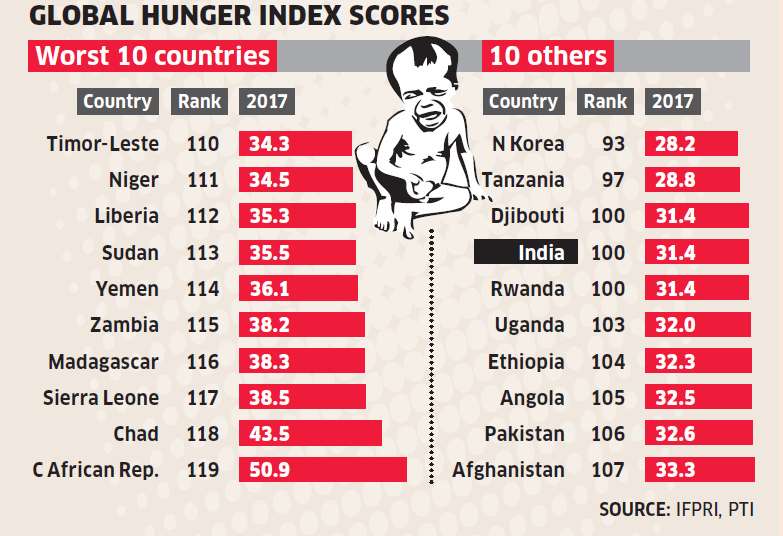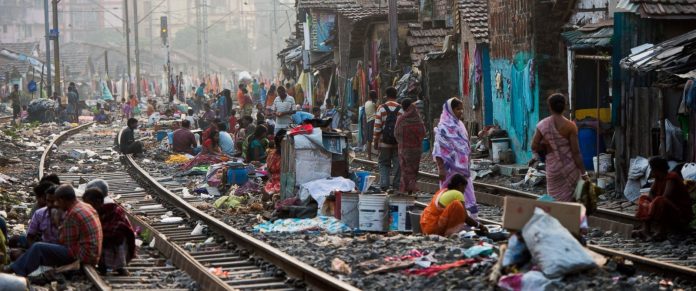ECONOMY
We as a nation have failed to ensure that all people irrespective of class lead a dignified living and have quality food at subsidised rates. The nation’a poor rank in terms of the GHI paints towards a very sorry picture.
The New Leam Staff

India has been ranked 103rd amongst the 119 qualifying countries in the Global Hunger Index (GHI) list which was published on 10th October 2018. The Global Hunger Index a parameter used to measure hunger at global, national and regional levels across the world. GHI is calculated through 4 important indicators- Undernourishment, Child Mortality, Child Wasting and Child Stunting.
The GHI score for India is very less and hence the ranking, which means that even after 70 years of independence, the state has not been able to fulfil its promise of “Roti, Kapda, Makan” a slogan that had been used by political leaders like Indira Gandhi during her tenure as the Prime Minister. Even after her regime came to an end, the slogan has been part of the agenda of political parties. This promise of a dignified living for the rural poor has been the basis of several political claims, agendas and entire election campaigns in the country.

We do not lack in the creative genius as far as coming up with new schemes is concerned but where we actually lack is in the implementation of the schemes. India is such a diverse country in terms of culture, geography, demography, people, food etc that every region demands a different or a specific nature of intervention to solve a particular problem or rather if we understand it this way, that the way in which x scheme is designed and implemented in Chhattisgarh cannot have the same nature of design and implementation strategy when it has to be applied in a region like Lahol Sipti(HP). Paradoxically what we have is a universal model for everyone whether it fits or not with the nature and character of a particular town or city.
The schemes that India has in place to ensure food security are the Food Security Bill(2013), Integrated Child development Scheme, Targeted Public Distribution System and Public Distribution System (TPDS and PDS), Fight hunger First Initiative Program, Mid- day Meal Scheme, Below Poverty Line(BPL), Antyodyaya Anna Yojana(AAY), Annapurana Scheme, Rajiv Gandhi Scheme for empowerment of Adolescent Girls, Emergency Feeding Programmes and states like Tamil Nadu have their own model to ensure food for all such as the Amma Canteen that sells subsidised quality food.
Why are we still witnessing a crisis wherein children are undernourished or hunger is all pervasive? One of the immediate reasons for this is the improper implementation of the available program. Such programs can’t be carried out properly primarily due to the widespread prevalence of corruption. India as a nation, is suffering from the ailment called corruption and will continue to suffer, unless moral principles and ethics at workplace are realised by people in all spheres of public life.. As per the Transparency International’s 2017 Corruption Perception Index, India ranks 81st amongst 180 countries in the corruption index, and as per its reports further the largest contributors to corruption are entitlement programs and social spending schemes enacted by the government of India.
The causes of undernourishment, child stunting and child mortality are not only a proper scheme to ensure food for all by the state, it has wider connotations like pre-natal and post-natal nutrition and health care of the mother and child.The first 1000 days after birth or till 6 months from birth constitute a crucial period of time for both the mother and child wherein it is important to ensure what is being feed to the mother such that she can breastfeed the child. A healthy diet for a new mother is very often not ensured, which in turn affects the overall health of both further leading to consequences such as stunted height, vitamin deficiency, obesity by overconsumption of low quality food etc.

Malnutrition, as stated by UNICEF, is not just lack of food, it is a combination of factors like insufficient protein, energy and micronutrients, frequent infections and disease, poor care and feeding practices further leading to problems like stunting and wasting. This happens because of lack of proper pre-natal and post-natal care of the child and the mother, lack of water and sanitation facilities, lack of knowledge on the importance of breast-feeding
India’s GHI ranking shows that we are lagging far behind and it is very important for the government to take necessary steps in that direction. As it has been stated by UNICEF and also mentioned as Goal 2 of Sustainable Development Goals, we as a nation ought to strive for a mission that asserts the goal “end hunger, achieve food security and improved nutrition, and promote sustainable agriculture”
Nutrition is an important area that must be emphasised to ensure quality breastfeeding. Breastfeeding ensures good health and creation of immunity that is important to fight many diseases.Therefore it is essential to understand the importance of nutrition and thus any policy framework or a social spending scheme should ensure that it is holistic and not serving a single purpose. The Food Security Bill, along with securing right to food for everyone should also ensure that right nutrition can be extracted from the food that is available.Post natal and pre natal care is of prime importance and hence every single measure should be directed towards it’s due implementation.














